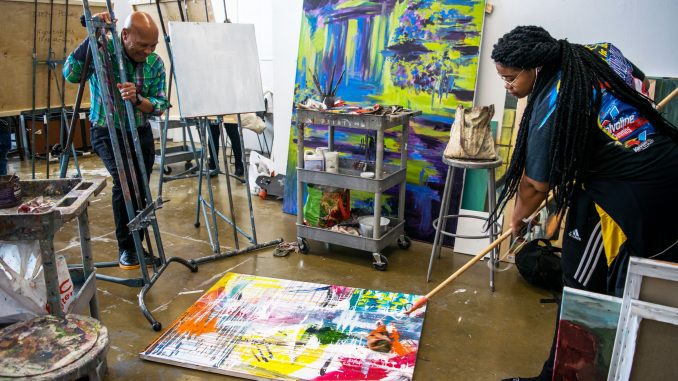
When Keith Morrison attended the School of the Art Institute of Chicago in 1960s, he never heard a single Black artist mentioned in class.
“None were in the art history books anywhere or any magazine,” said Morrison, a painting professor who was born in Jamaica. “And that was the time a lot of people were emerging, who are rather well known now, who were turning the card upside down.”
On Aug. 6, Jamaica’s Governor-General Sir Patrick Allen awarded Morrison the national title of Commander in the Order of Distinction. The award recognizes Morrison for his “outstanding and important services to Jamaica.”
“It was a surprise,” he said. “I was on the West Coast and came back, and a friend said I was in the papers in Jamaica. I listened to my voicemail and saw that there was a message on there from 10 days ago telling me about it.”
In his career, which has spanned more than five decades, Morrison has served as an art dean for four universities, including Temple, curated exhibits and served as the Jamaican representative for the 2001 Venice Biennale, a prestigious international art exhibition held every two years.
Within his art, Morrison attempts to depict the Black experience, gathering inspiration from African-American and Jamaican music, style, speech, sports and history in the form of figurative art, or art that depicts people.
At age 17, Morrison came to the United States to study art in Chicago, where he earned his BFA in 1963 and his MFA in 1965. There, Morrison learned about abstract expressionism, a style of art developed by American painters in the 1940s and ’50s characterized by spontaneous brush marks and the absence of literal representations of people or other real-life objects.
“There were students from about every part of the world,” Morrison said. “But the [Chicago] faculty took the position that you can wear any sari, dashiki or toga you want, you can speak any language you want, but in my classroom you will do abstract expressionism.”
Morrison credits his “competitive” nature to his drive to excel in abstract expressionism. He temporarily abandoned figurative art to learn the new “language” of abstract work. He said his figurative work today is still influenced by abstract art.
While in school, Morrison began to notice little recognition being given to African-American artists in the field. Morrison said his peers thought this lack of Black artist recognition was “inconsequential.”

After graduating in 1965, Morrison found that breaking into the art world as a Black artist was challenging, especially for artists who depicted Black people in their work.
“When you’re a person of color, especially…a Black person, your chances of getting an exhibition, if you did art with Black people in it, were very very slim to none,” Morrison said.
In 2014, Valerie Cassel Oliver, the senior curator at the Contemporary Arts Museum Houston, organized “Black in the Abstract,” a two-part exhibit examining the history of African-American abstract painters. In an ARTnews article about the exhibit, Oliver said Black abstract painters in the 1960s were often “marginalized on both ends of the spectrum.”
“Oftentimes abstract painting is not as celebrated as more figurative work by the Black community,” Oliver told ARTnews. “From the mainstream art world, it’s just the sense of not being preoccupied with what Black artists are doing, period.”
With abstract expressionism as the “dominant” style in the ’60s, Morrison said many Black artists were excluded from exhibits because their art depicted Black people.
“I got into a lot of shows, major shows, which I might not have gotten into if I’d done figurative art with people of color, because at those shows, I saw no people of color,” Morrison said.
As a Tyler student of Jamaican descent, Sarah Roebuck said she understands the importance of Black artists receiving proper recognition for their work and accomplishments.
“It is extremely important that Caribbean people are allowed positions of power in otherwise white-dominated spaces,” said Roebuck, a senior historic preservation major. “Caribbean people have their own individual stories to tell. … All experiences of Africans throughout the diaspora are ultimately fairly similar.”
Morrison said he’s noticed an increase in the racial diversity of Tyler’s student body.
In Fall 2016, white students made up 66 percent of Tyler students, while they comprised 77 percent 10 years before.
“I am very encouraged by seeing so many different kinds of students of color in Tyler, this year especially,” Morrison said. “Now I see so many students of color, of different kinds. It’s become much more healthy. We’re not yet anywhere where we should be [but] we are much much further ahead than before.”
Morrison said his work continues to examine America’s “underbelly” of racism, but he’s always evolving as an artist.
“I don’t know where it goes because I leave myself open as a sponge to see what comes in,” Morrison said.



Be the first to comment